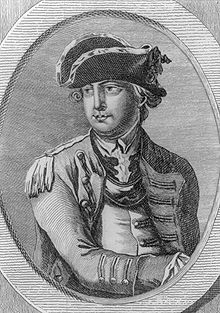
The picture above is of Charles Lee, a British subject who served in the British Army, served in the Polish Army and The Portuguese Army, he also served as George Washington’s Second-In Command in the Continental Army. He resume was incredible, yet he lacked tact and decorum and took many actions during his career that can best be described as “looking out for himself”.
In regards to the American Revolution he is rarely given the coverage that he deserves. He left Britain after having burned several bridges and basically destroying his chance for further promotion and found himself in America just as the conflict with Britain was starting to come to blows. He was a rabid patriot, and is well documented among the first to call for independence. He supported the cause full on and when the arguing turned to open warfare he expected to be called on to lead the American armies against the British invaders. As far as resumes go he was the most experienced patriot officer, he had fought and led men in several wars and all things considered he may have been a good choice, but the Congress went George Washington, and Lee never forgave any of them.
As talented as Lee was on the battlefield he was very thin-skinned and this led him into many difficulties in the early part of the war. He was instrumental in several early battles and as his star rose on the horizon he truly felt that he should be in charge and thus began a campaign to criticizes and undermine General Washington at every turn. Even to the point of purposefully delaying carrying out his orders and at time straight up ignoring them. There is much to go into with Lee and this subject but there is one instance in particular that needs looked at.
On December 13, 1776 Lee was captured by the British and taken to New York as a prisoner. Being an aristocrat as well as a highly valued political prisoner he did not suffer as enlisted men or common soldiers would have, During his captivity he enjoyed the company of many high-ranking British officers, many that he had even served with just years before. Late night dinners and audiences with the British Commander General Howe became par for the course, often when the topic of the ongoing war would come up Lee would share his thoughts on what he would be doing different. While he enjoyed the company he was still a prisoner and complications in the prisoner exchange system frustrated him to end. He blamed everyone from Congress to Washing for his imprisonment. It would not be until May of 1777 that he was freed and rejoined the Continental Army.
What happened next is well documented. In June Lee was tasked with leading an advanced corps against the British rearguard at Monmouth New Jersey. One thing led to another, Lee’s men retreated, Washington was upset, Lee was fired and ended up never serving in the Continental Army again. (yes, a vast over simplification for sure.)
In 1858 a document titled “Mr. Lee’s Plan, 29th March 1777” was found and verified as authentic. This document, written by Lee and addressed to General Howe, laid out a series of military strategies that lee suggested could be used to defeat the Americans and bring them back into the fold. Some believe this was an attempt by Lee to
plant false information for Howe, but most see it for what it was Lee, frustrated that he was not in command, frustrated by the slowness of his exchange, upset at not getting the praise he felt he deserved, turned coat and became one of the most notorious traitors of the American Revolution. The British did not follow his plan, had they perhaps many things would be different. But in a world where Benedict Arnold is synonymous with traitor, Charles Lee should be sharing the same moniker.
